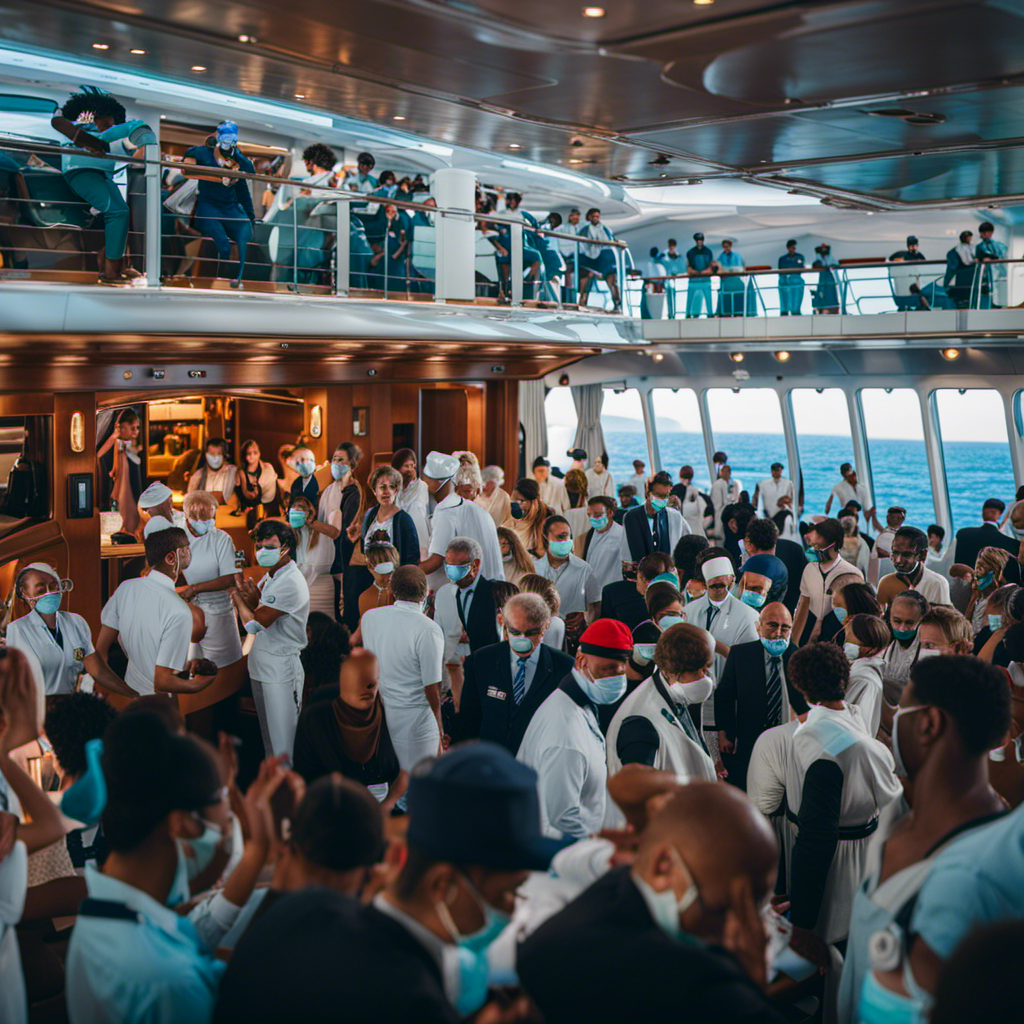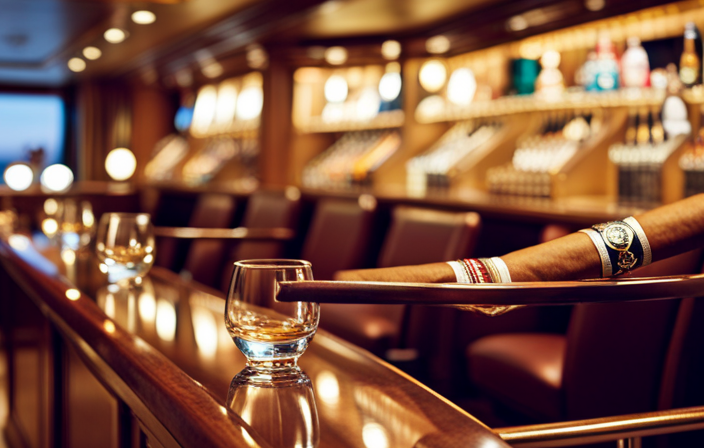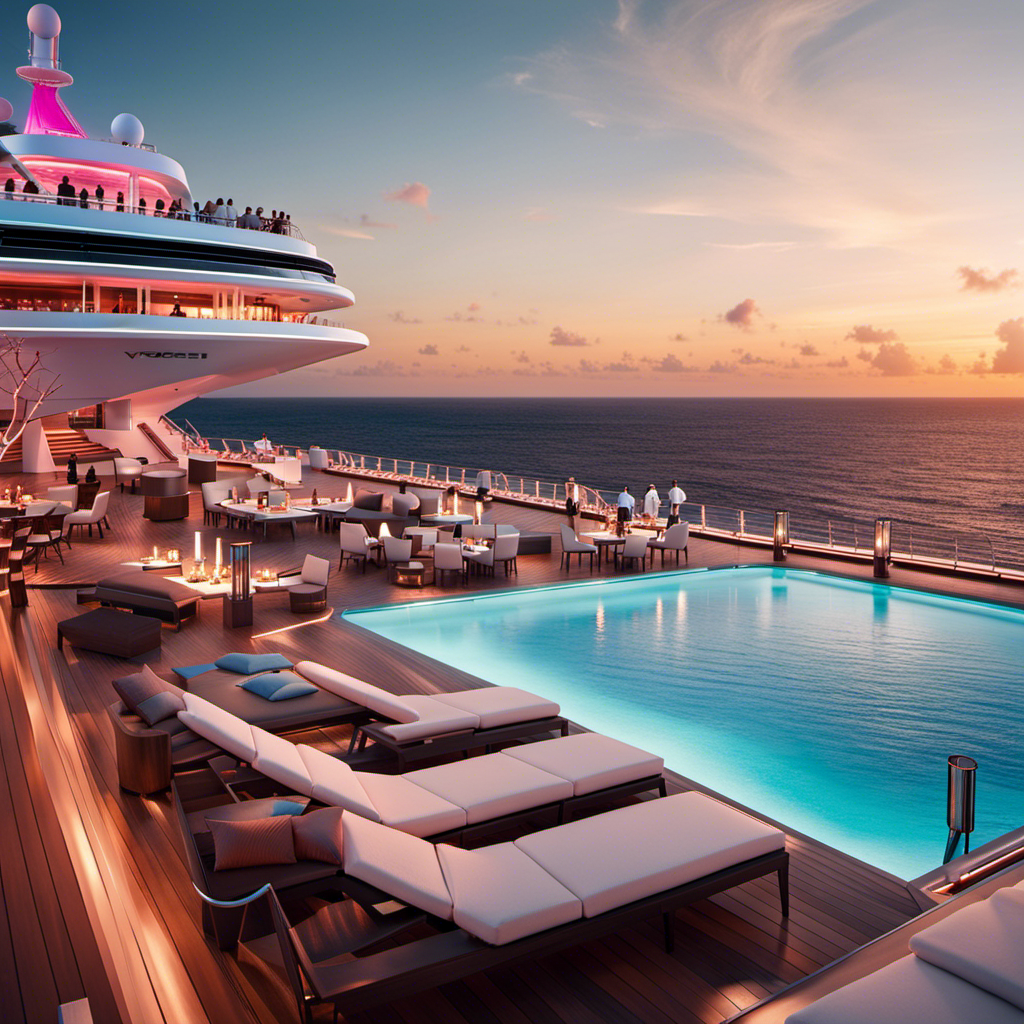While on the deck of the cruise ship, listening to the crashing waves beneath, my thoughts turn to the unsettling rise in COVID cases these vessels are dealing with.
In just one week, the number of ships with potential cases has doubled, despite the stringent protocols in place. With the CDC assigning color status to each ship, indicating the level of risk for transmission, it is disconcerting to see that nearly 55% of ships now have orange or yellow status.
The lack of specific case numbers and variant details raises concerns, but it is likely that the Omicron variant is at play. Cruise lines are scrambling to address this spike and prevent further spread, implementing masking rules, extended testing policies, and considering additional measures like universal testing at the pier and requiring booster shots.
It is my hope that this surge in cases is temporary, and that the industry can swiftly adapt to ensure the safety of all passengers and crew.
Key Takeaways
- The number of cruise ships with potential COVID cases has doubled in one week.
- Stringent protocols requiring vaccines, testing, and masking have not completely prevented cases.
- The CDC assigns color status to each ship, with orange or yellow indicating possible cases and red indicating sustained transmission.
- The percentage of ships with orange or yellow status has sharply risen, reaching nearly 55% on December 20.
The Doubling of COVID Cases on Cruise Ships
The number of COVID cases on cruise ships has doubled in just one week, indicating a concerning surge in infections. This increase raises questions about potential causes and the impact on the cruise industry.
Despite stringent protocols requiring vaccinations, testing, and masking, these measures have not completely prevented cases. The CDC assigns color status to each ship, with green indicating no potential cases, orange or yellow suggesting possible cases, and red indicating sustained transmission. The correlation between color status and cases on land is evident, with the percentage of ships with orange or yellow status sharply rising recently.
This rise, coupled with the increase in ships with orange or yellow status, highlights the need for updated protocols. Cruise lines have responded by implementing masking rules and extending testing policies. However, the spike in potential cases is hopefully temporary, and cruise lines remain committed to addressing the situation and preventing further spread.
Inadequacy of Protocols in Preventing COVID Cases
I’ve noticed that the protocols in place aren’t completely effective at preventing COVID cases. Despite stringent measures such as requiring vaccines, testing, and masking, the number of cruise ships with potential COVID cases has doubled in just one week. The CDC assigns color statuses to each ship based on the presence of COVID-like illness. However, these color statuses don’t provide specific case numbers or variant details. The correlation between color status and cases on land is concerning, with the percentage of ships with orange or yellow status sharply rising. This ineffectiveness of measures is having a significant impact on the cruise industry. Cruise lines are implementing additional protocols, such as extended testing and masking rules, but more may need to be done, such as universal testing at the pier or requiring booster shots. The situation is being closely monitored, and adjustments to protocols may be necessary.
| Key Points |
|---|
| Protocols in place aren’t completely effective at preventing COVID cases on cruise ships. |
| The number of cruise ships with potential COVID cases has doubled in one week. |
| The CDC assigns color statuses to each ship, indicating the presence of COVID-like illness. |
| Cruise lines are implementing additional protocols, but more may need to be done. |
CDC Color Status: An Indicator of Potential COVID Transmission
Based on the recent rise in orange and yellow color statuses, it is evident that the CDC’s color status system serves as an indicator of potential COVID transmission on cruise ships. The accuracy of color status is crucial in understanding the level of risk onboard and its impact on the cruise industry. Here are four key points to consider:
-
Color status accuracy: The CDC assigns color status based on the percentage of passengers and crew with COVID-like illness. Orange status indicates a lower threshold, while yellow status represents a higher threshold. This system helps identify potential cases and assess the level of transmission on each ship.
-
Impact on cruise industry: The rise in orange and yellow color statuses has significant implications for the cruise industry. It highlights the challenges faced by cruise lines in preventing COVID transmission despite stringent protocols. The industry must adapt and strengthen protocols to ensure passenger safety and regain public trust.
-
Monitoring and response: Cruise lines are closely monitoring the situation and adjusting their protocols accordingly. This includes implementing masking rules, extending testing policies, and considering additional measures like universal testing at the pier or booster shot requirements. The priority is to address the spike in potential cases and prevent further spread.
-
Maintaining safety: Despite the recent increase in potential cases, cruise lines remain committed to providing a safe travel experience. Effective protocols, such as vaccines, testing, and masking, are in place to minimize the risk of COVID transmission. The situation is being closely monitored, and protocols may be adjusted as needed to ensure passenger safety and confidence in the industry.
Correlation Between Color Status and Land Cases
Monitoring the correlation between color status and land cases reveals a sharp rise in potential COVID transmission on cruise ships. The effectiveness of color status indicators in predicting the spread of the virus on cruise ships is becoming evident.
With the impact of the Omicron variant, the number of ships with orange or yellow status has significantly increased. On December 13, only 24% of ships had orange or yellow status, but by December 20, nearly 55% of ships fell into this category. In just one week, the number of ships with orange or yellow status has risen by 33. This rise aligns with the global spike in Omicron cases.
Cruise lines are taking this situation seriously and adapting their protocols to address the surge and prevent further spread. The situation is closely monitored, and adjustments may be made to protocols as needed.
Sharp Rise in Ships With Orange or Yellow Status
I’m closely observing the significant increase in ships with orange or yellow status. This surge in potential COVID cases on cruise ships has the potential to have a significant impact on the cruise industry.
The consequences could include reduced passenger confidence, cancellations, and financial losses for cruise lines. The sharp rise in ships with orange or yellow status indicates a higher risk of COVID-like illness onboard. While cruise lines have implemented protocols such as vaccination requirements, testing, and masking, these measures have not completely prevented cases.
The lack of specific case numbers and variant details makes it difficult to assess the exact situation. However, it is likely that the rise in cases on ships is linked to the global spike in Omicron cases. Cruise lines are responding by adapting their policies and implementing additional measures, such as extended testing and possible booster shot requirements.
The situation is being closely monitored, and further adjustments to protocols may be necessary to ensure the safety of passengers and crew.
Lack of Transparency in Case Numbers and Variants
I don’t have access to specific case numbers or variant details, which makes it challenging to fully evaluate the situation.
However, there are transparency challenges regarding the cruise ship COVID cases. The lack of specific case numbers and variant details hinders our understanding of the extent of the problem.
The impact of different variants, including the concerning Omicron variant, remains unclear due to the limited information available. This lack of transparency poses challenges in assessing the overall risk and implementing appropriate measures.
It is crucial to have access to detailed data to make informed decisions and effectively manage the situation. Without this information, it becomes difficult to gauge the effectiveness of current protocols and evaluate the need for additional measures to contain the spread of the virus on cruise ships.
Response and Updated Protocols by Cruise Lines
Adapting to the rise in potential cases, cruise lines have implemented updated protocols, such as extended testing and masking rules for passengers. These strengthened measures aim to enhance the effectiveness of protocols already in place.
For instance, Norwegian Cruise Lines has extended its policy of testing all passengers at the terminal through January 2022. Additionally, cruise lines have implemented masking rules for passengers in indoor areas.
The response from cruise lines demonstrates their commitment to the safety and well-being of passengers and crew members. Carnival Corporation CEO has expressed confidence in the company’s effective protocols.
While the recent spike in potential cases is concerning, cruise lines are taking the rise in Omicron seriously and are continuously adapting their policies to address the situation. The effectiveness of these updated protocols will be closely monitored and adjusted as needed.
The Temporary Nature of the Surge in Cases
While the recent surge in COVID cases on cruise ships is concerning, it is important to note that this increase is likely temporary in nature. Cruise lines are actively working to address the spike and prevent further spread of the virus.
Stringent protocols, such as vaccines, testing, and masking, have been implemented to mitigate the risk, but they are not foolproof. It is crucial to understand that these protocols greatly reduce the likelihood of transmission, but they cannot completely eliminate it.
Cruise lines are closely monitoring the situation and may adjust their protocols as needed to ensure the safety of passengers and crew. Additionally, the spike in cases on ships mirrors the global surge in Omicron cases, further highlighting the temporary nature of this increase.
The priority remains on preventing spikes and safeguarding the health and well-being of everyone on board.
Continuous Monitoring and Adjustment of Protocols
Monitoring and adjusting protocols is imperative to ensure the ongoing safety and well-being of passengers and crew amidst the recent increase in potential cases.
As the number of cruise ships with potential COVID cases continues to rise, it is crucial for cruise lines to continuously monitor the situation and make necessary adjustments to their protocols. This includes implementing stricter masking rules for passengers in indoor areas, extending testing policies, and considering additional measures like universal testing at the pier or requiring booster shots.
Continuous monitoring allows cruise lines to stay proactive and address any potential risks promptly. By staying vigilant and adapting protocols as needed, cruise lines can maintain a safe environment for everyone on board.
The health and safety of passengers and crew remain the top priority, and protocol adjustment plays a vital role in achieving that goal.
Frequently Asked Questions
How Many COVID Cases Are There Currently on Cruise Ships?
As of now, I don’t have the specific number of COVID cases on cruise ships. However, the recent surge in cases highlights the impact on the travel industry and the need for cruise ship protocols to be strengthened.
What Specific Variants of COVID Are Present on Cruise Ships?
I don’t have the specific information on the variants of COVID present on cruise ships. However, it’s likely that Omicron is in play due to the rise in cases. This surge in cases is impacting the cruise industry.
Are There Any Cruise Ships That Have Not Experienced Any Potential COVID Cases?
There are currently no cruise ships that have not experienced any potential COVID cases. Despite stringent safety protocols, the impact of COVID on the cruise industry has led to an increase in cases on ships.
Are There Any Plans to Implement Universal Testing for All Passengers at the Pier?
Yes, there are plans to implement universal testing for all passengers at the pier. This additional safety measure aims to further prevent the spread of COVID-19 and ensure the well-being of everyone onboard cruise ships.
What Measures Are Cruise Lines Taking to Address the Spike in COVID Cases and Prevent Further Spread?
Cruise lines are implementing measures to address the spike in COVID cases and prevent further spread. These include enhanced sanitation protocols, cruise ship vaccination requirements, and potentially strengthening protocols such as universal testing at the pier or requiring booster shots.
Claire, a creative soul with an unquenchable thirst for storytelling, is an integral part of the Voyager Info team. As a dedicated writer, she weaves captivating narratives that transport readers to enchanting cruise destinations and beyond.
Claire’s love affair with writing began at an early age when she discovered the magic of words and their ability to craft worlds and emotions. Her innate curiosity led her to explore various literary genres, but it was travel writing that truly captured her heart. Drawing inspiration from her own globetrotting adventures and encounters with diverse cultures, Claire embarked on a journey to become a travel writer par excellence.











